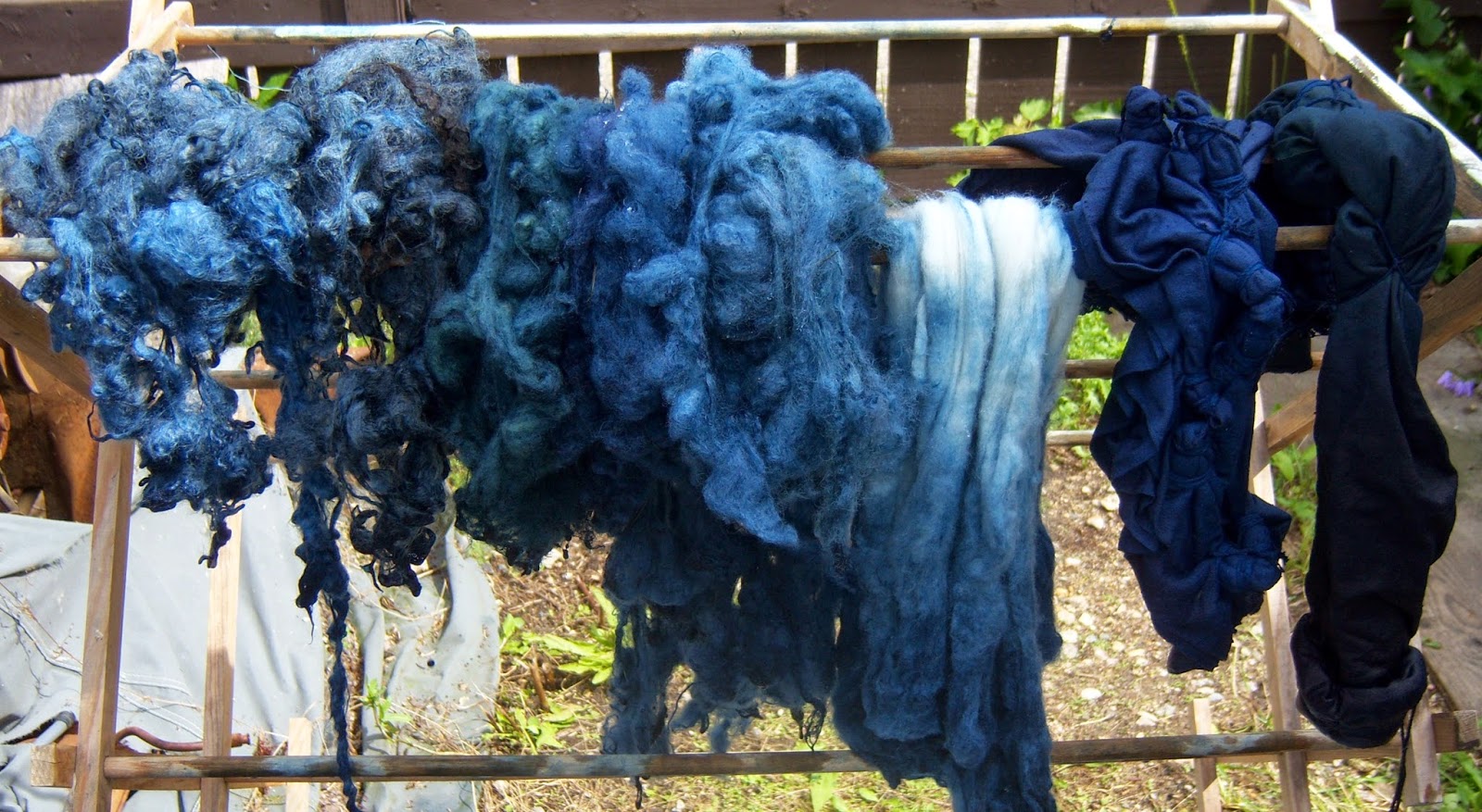I played with the immersions, dipping parts of the fabric and the top while leaving other parts either undyed or with fewer dips. The cotton had a total of 5 dips, including some partial immersions; the silk had a total of 4 dips:
I immersed the previously dyed Corriedale twice. The Gotland fleece at the top left of the above photo shows its natural colours. After 3 dips, the blues were like midnight:
 |
| Left to Right: Corriedale, darker Gotland in the middle, Corriedale, Finn wool top and the two pieces of cloth. |
After the final dip and oxidation, I neutralized the protein fibres in vinegar and water and washed the fabrics in hot water and Sacred Earth bar soap. (This locally made soap is fantastic; click on the link to learn more about it.) The rinse water for the cloth ran clear in a couple of rinses, but the wool required washing in Synthrapol and hot water to stop the dye from running. The amount of colour in the water was amazing, but the rinse water ran clear. Because of that, I decided to re-wash the fleece which I'd dyed several days ago because I could not get the darker colours to stop crocking. This time, I used Synthrapol (used for removing excess dye) in the wash water and it made all the difference. The rinse waters cleared quickly and the crocking, if not completely gone, is at least minimized enough that I should be able to spin the fibres without turning into a Smurf.
The overall effect on the cloth is a bit "old hippie," but parts of the fabrics are spectacular. (I have nothing against hippies, old or new. It's just not a look I should revisit any time soon.)
This small section of the cotton is a work of art in itself. I'd like to say I planned it. I'd like to say that, but I can't. Well, I could, but it would be a lie. The piece reminds me of Kate Bush's lines in An Architect's Dream, "That bit there-it was an accident, but he's so pleased. It was the best mistake he could make. It's my favourite piece; it's just great.":
 |
The indigo kit stated that it should be used for dyeing cotton, linen, rayon and silk and it certainly dyed these fibres easily. It works on wool, but with any indigo dye recipe I've used, the wool has crocked and continued to do so until the fibre has been stored away for some time. As I mentioned before, crocking is not considered a flaw in traditional indigo cultures; however, where indigo was indigenous, the primary fibres dyed were usually cotton, linen and silks, so it's not surprising to get more light and wash fast colours on these materials. I'm pleased with the richness of the colours I dyed over the past 5 days and I will certainly use this kit again because the ease of use and the safety of the bath more than compensates for the extra work required in finishing the fibres. This is everything I dyed since I first tested the bath:
The vat is still active and I'll continue to use it for the rest of the summer, but it's time to write about something else. If another happy accident arises, I'll be sure to let you know. Another weekend over, another week begins and it's back to yoga, teaching, spinning and knitting. There are dogs to walk, cats to feed. Life is good.
Late last night, I looked for the Perseid Meteor Shower and wondered at the marvel of the sky. Blue Goes for Down everywhere we look. Blue Goes for Down.
Namaste.
Late last night, I looked for the Perseid Meteor Shower and wondered at the marvel of the sky. Blue Goes for Down everywhere we look. Blue Goes for Down.
Namaste.





No comments:
Post a Comment